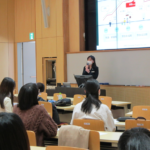4. Childhood Education
Moritaki Ichiro, who lost sight in his right eye in the bombing, and was active in movements to support atomic bomb victims, led Hiroshima Kodomo wo Mamorukai (Hiroshima Association for Protecting Children), an organization for Orphans of the a-bomb, during his time as a professor at Hiroshima University. The association was formed in February 1953. The association promoted moral adoption and member university students conducted a fact-finding investigation pertaining to children in elementary and junior high schools and childcare facilities in Hiroshima City. Moritaki argued in a paper written based on his research, entitled “A-bomb Orphans”30:
“Among the children who evacuated as a group or evacuated to their relatives, not only children who lost both parents to the atomic bomb or atomic bomb-related illnesses, but also those children who lost either of their parents were in a terrible plight. Because of this, these children were also called atomic bomb orphans. This was a point which caused problems.”
Strictly defined, orphans are children who have lost both parents. However, in Hiroshima, which was dreadfully devastated, even those children who still had mothers or grandparents still faced distress because of difficulties in supporting them, worsened by atomic bomb-related illnesses and the destruction of infrastructure. Amid damaged local communities and scarce social welfare, children who lost their parents were the first to face harsh difficulties and social confusion. As they grew up, they struggled with difficult living conditions. While support efforts gathered steam as restoration continued, the atomic bomb orphans were still subjected to thoughtless stares mixed with sympathy.
According to a nationwide survey on orphans summarized by the Ministry of Health and Welfare on February 1, 1948, the total number of orphans who lost both of their parents was 123,511. 28,238 out of them were war orphans. 11,351 were orphans repatriated from overseas territories. Hiroshima Prefecture counted 5,975, the largest number in Japan. Among them, 456 children were cared for in institutions and the rest were under the custody of their grandparents, mothers, siblings, relatives or acquaintances. The report said that out of 5,975 children, 2,541 were war orphans. It is not unreasonable to posit that a major cause of their parents’ death was the atomic bombing.
However, a considerable number of a-bomb orphans were looked after by their relatives residing outside of Hiroshima or moved to Osaka or Hiroshima to survive.
In 1953, Hiroshima Kodomo wo Mamorukai confirmed 432 a-bomb orphans among 45 public elementary and junior high schools in Hiroshima City. Those children were infants or in the early elementary grades at the time of the atomic bombing. The association also found that more than 1 out of 4 children (28%) endured conditions where they were “being cared for by needy people who could not even purchase clothing and food.” 31
In a survey conducted in October 1954 with broader research targets, it was revealed that children under such circumstance totaled 1,810, 802 of whom were elementary school students (378 female students) and 1008 were junior high school students (539 female students). At that time, the number of public elementary schools was 34, and that of national schools was two, with total students numbering 43,000. The number of junior high schools was 26, with 14 municipal schools, 10 private schools and 2 national schools, with 21,000 total students32.
The reasons for 1810 students’ being a-bomb orphans were: losing parents, 156 (50 were elementary school students); losing a father, 1240 (624 elementary school students); and losing a mother, 414 (128 were elementary school students). At households which lost fathers, mothers became the only breadwinner and struggled to raise their children with the burden of single parenthood by engaging in daily contract jobs offered by the government as a measure against unemployment.
According to a survey on a-bomb orphans conducted by a social science seminar of Hiroshima University before 1960, nearly 1,300 lived outside of Hiroshima Prefecture, working in an industry which did not require personal references, and the turnover was very high.33 In the city that had suffered from the bombing, being an orphan was a disadvantage in terms of job hunting. Those who were raised in the institutions for war children had no choice but to be independent after graduating from junior high school by doing live-in work or working for small factories.
30 Ichiro Moritaki, Genbakukoji (A-bom Orphans), Genbaku to Hiroshima (A-bomb and Hiroshima), Heiwa to Gakumon wo Mamoru Daigakujin no Kai, 1957, p47
31 The survey result is recorded in Genbaku to Hiroshima
32 General Affairs Bureau, General Affairs Division, Hiroshima City (ed.), Hisei Youran (City Guide), Hiroshima City Hall, 1955, pp114-117
33 Hiroshima City Hall (ed.), Hiroshima Shinshi Dai 1 kan (New Hiroshima History vol. 1), Hiroshima City Hall, 1961, pp655-656








